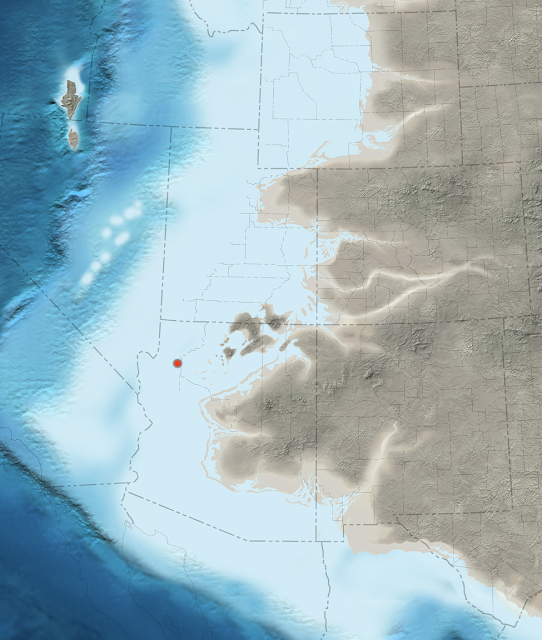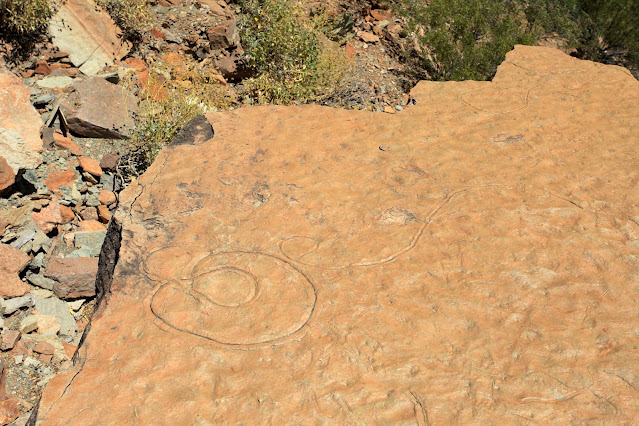I enjoy sharing my 47 years of experience in the Grand Canyon with interested readers. Although much travel has been suspended during the Covid pandemic, I reach back into the archives of photos I have accumulated to share interesting items of Grand Canyon and World geology - enjoy!
The Grand Canyon is nearly 280 miles (450 km) long! And no less than 26 named rock units are exposed in its walls. John Wesley Powell, in seeking funding for his river trip survey in the 1860s wrote to Congress saying, "the Grand Cañon of the Colorado will give the best geological section on the continent."
 |
| Paleogeographic map of the southwest USA 505 Ma when the Bright Angel Shale was deposited. The red dot denotes the location of the fossil in this posting. Map courtesy of Ron Blakey and DeepTime Maps. |
In far western Grand Canyon, the Cambrian Bright Angel Shale thickens and becomes more carbonate-rich, documenting the continental transgression of the paleo-Pacific Ocean onto the edge of North America. Recently dated at about 505 Ma (Mega-annum or million of years ago) this progressive onlap of the sea occurred only 37 million years after the Great Cambrian Explosion, when more simple life forms evolved into many of the genera familiar to marine biologists today. Mollusks, corals, arthropods, and other forms made their appearance and were abundant in the area that was to become the Grand Canyon.
One form of arthropod is the trilobite and about 10 years ago, a river guide in Grand Canyon showed me this spectacular trace where a specimen crawled around in the soft, limey mud.
This is the largest slab of rock, which fell from the cliff above to expose a fossil-rich bedding plane.
Note the gentle and discreet symmetrical ripple marks on the right hand side of the slab. When the ripple marks are symmetrical in cross-section, they denotes fluctuating current directions (as opposed to asymmetrical ripple marks formed from singular current directions as in rivers). These here likely formed in oscillating currents in relatively shallow water.
Two individual specimens are represented on the slab as the trackway to the left's a bit smaller in diameter than the more obvious trackway on the right.
This ichnofossil (or trace fossil) is called Cruziana. (Yes, trace fossils have binomial nomenclature like the animals that created them). This one is really well-preserved and shows where the appendages of the animal pushed the sediment backwards, leaving an axial groove in the middle. We can also tell something about the direction of movement of the animal from this view. It appears that the animal came and "landed" in the sediment from the top right quadrant, then traveled down before turning left. It then makes the large loop around to the right on top before looping again within the larger loop. All of this can be ascertained because of the way the "exit track" on the middle far right seems to cross over and disturb the underlying track. This is amazing preservation.
One form of arthropod is the trilobite and about 10 years ago, a river guide in Grand Canyon showed me this spectacular trace where a specimen crawled around in the soft, limey mud.
This is the largest slab of rock, which fell from the cliff above to expose a fossil-rich bedding plane.
Note the gentle and discreet symmetrical ripple marks on the right hand side of the slab. When the ripple marks are symmetrical in cross-section, they denotes fluctuating current directions (as opposed to asymmetrical ripple marks formed from singular current directions as in rivers). These here likely formed in oscillating currents in relatively shallow water.
Two individual specimens are represented on the slab as the trackway to the left's a bit smaller in diameter than the more obvious trackway on the right.
This ichnofossil (or trace fossil) is called Cruziana. (Yes, trace fossils have binomial nomenclature like the animals that created them). This one is really well-preserved and shows where the appendages of the animal pushed the sediment backwards, leaving an axial groove in the middle. We can also tell something about the direction of movement of the animal from this view. It appears that the animal came and "landed" in the sediment from the top right quadrant, then traveled down before turning left. It then makes the large loop around to the right on top before looping again within the larger loop. All of this can be ascertained because of the way the "exit track" on the middle far right seems to cross over and disturb the underlying track. This is amazing preservation.
Many folks are more familiar with the many annelid worm burrows that are present in the Bright Angel Shale in Grand Canyon. They are also abundant here.
The fossil slabs in context to the river.
Our boar drifts by the trackway site.
In the lower left quadrant, it appears that the trilobite "took off" once again after making the two loops.
Another view with lens cap for scale.
Please do not disturb in any way fossil track sites. These are extremely precious specimens that must be preserved. And enjoy the Grand Canyon!












Thanks for sharing! I've never seen traces like that before!
ReplyDeleteYou are welcome Mindy!
DeleteThese are awesome! Great share.
ReplyDeleteFascinating. Rocks are the library of geological time and evolution.
ReplyDeleteAwhile back you indicated you were working on a new geologic river log of the Grand Canyon. Any word on when that will be available?
ReplyDeleteWe are currently in the review stage, where two professional geologists read the text and make suggestions. I'm guessing it will be ready by the 2023 river season. Thanks for your patience.
DeleteHello Wayne, I am Zekun Wang from the Natural History Museum, UK. The sixth photo is classified as Psammichnites isp. according some researchers, and could be left by shelled molluscs. And I am especially insterested in the tidal-influenced, even putative subaerial Psammichnites isp.. Could I have the permission to reuse this photo in my publications, and you will be properly credited. Best wishes.
ReplyDeleteHello Wayne, I am Zekun Wang from the Natural History Museum. I am especially interested in the Psammichnites isp. (sixth photo) in this post, which could be left by (shelled) mollusc according to some researchers. This would be very interesting for tidal-influenced, even emergent environments. Could I have the permission to reuse this photo? And you will be properly credited. Best wishes, Zekun.
ReplyDeleteZekun - What Natural History Museum are you at? Please send me your email address and I can share the original photo with you. Thank you, WR
DeleteUK's Natural History Museum, working on interdisciplinary studies between palaeontology/ichnology and computational mechanics/mathematics. This is my email: zekun.wang@nhm.ac.uk Thank you so much. Zekun
Delete